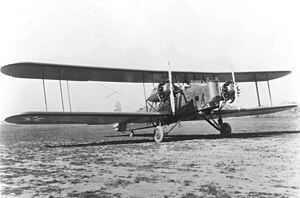Design and development
It was originally ordered as the LB-10A (a single-tail modification of the Keystone LB-6), but the Army dropped the LB- 'light bomber' designation in 1930.
Although the performance of the B-3A was hardly better than that of the bombers flown at the end of World War I, it had come a long way. In terms of its safety, it was far superior to its oldest predecessors.
The B-3A was the last biplane operated by the US Army; it remained in service until 1940. A few years after it was first produced, the introduction of all-metal monoplanes rendered it almost completely obsolete.
LB-10The last of the 17
LB-6s ordered (S/N 29-27) was converted with a re-designed single fin and rudder and two 525 hp Wright R-1750E engines. Delivered to Wright Field on 7 July 1929, it was wrecked on 12 November 1929.
LB-10AThis version used Pratt and Whitney R-1690-3 Hornet engines and was slightly smaller, both wingspan and fuselage. A total of 63 were ordered (S/N 30-281/343). All were re-designated as the B-3A before any deliveries were made, with the final 27 built as B-5A with Wright engines.
B-3A36 ordered as LB-10A and delivered as B-3A (S/N 30-281/316). The first aircraft was delivered in October 1930.
B-5AOrdered as B-3A, re-engined with Wright R-1750-3 Cyclone engines, 27 built (S/N 30-317/343).
United StatesUnited States Army Air Corps2d Bombardment Group, Langley Field, Virginia20th Bomb Squadron - operated B-3A and B-5A 1931-193249th Bomb Squadron - operated B-3A and B-5A 1931-193296th Bomb Squadron - operated B-3A and B-5A 1931-19324th Composite Group, Nichols Field, Luzon, Philippines28th Bomb Squadron - operated B-3A 1932-19372nd Observation Squadron- operated B-3A 1938-19405th Composite Group, Luke Field, Territory of Hawaii23d Bomb Squadron - operated B-5A 1932-193772d Bomb Squadron - operated B-5A 1932-19366th Composite Group, France Field, Panama Canal Zone25th Bomb Squadron - operated B-3A 1932-19367th Bombardment Group, March Field, California9th Bomb Squadron - operated B-3A 1931-193411th Bomb Squadron - operated B-3A 1931-193431st Bomb Squadron - operated B-3A 1931-193419th Bombardment Group, Rockwell Field, California30th Bomb Squadron - operated B-3A 1932-193632d Bomb Squadron - operated B-3A 1932-1935Air Corps Advanced Flying School , Kelly Field, Texas42d Bomb Squadron - operated B-3A and B-5A 1935-1936 PhilippinesPhilippine Army Air Corps10th Bombardment SquadronGeneral characteristics
Crew: 5Length: 48 ft 10 in (14.9 m)Wingspan: 74 ft 8 in (22.8 m)Height: 15 ft 9 in (4.8 m)Wing area: 1,145 ft² (106.4 m²)Empty weight: 7,705 lb (3,495 kg)Loaded weight: 12,952 lb (5,875 kg)Max. takeoff weight: lb (kg)Powerplant: 2 × Pratt & Whitney R-1690-3 radial engines, 525 hp (392 kW) eachPerformance
Maximum speed: 114 mph (98 kn, 183 km/h)Cruise speed: 98 mph (85 kn, 158 km/h)Range: 860 mi (760 nmi, 1,400 km)Service ceiling: 12,700 ft (3,870 m)Rate of climb: 530 ft/min (2.7 m/s)Wing loading: 11.31 lb/ft² (55.42 kg/m²)Power/mass: 0.0811 hp/lb (133 W/kg)Armament
Guns: 3 × .30 in (7.62 mm) machine gunsBombs: 2,500 lb (1,100 kg); 4,000 lb (1,800 kg) on short runs
